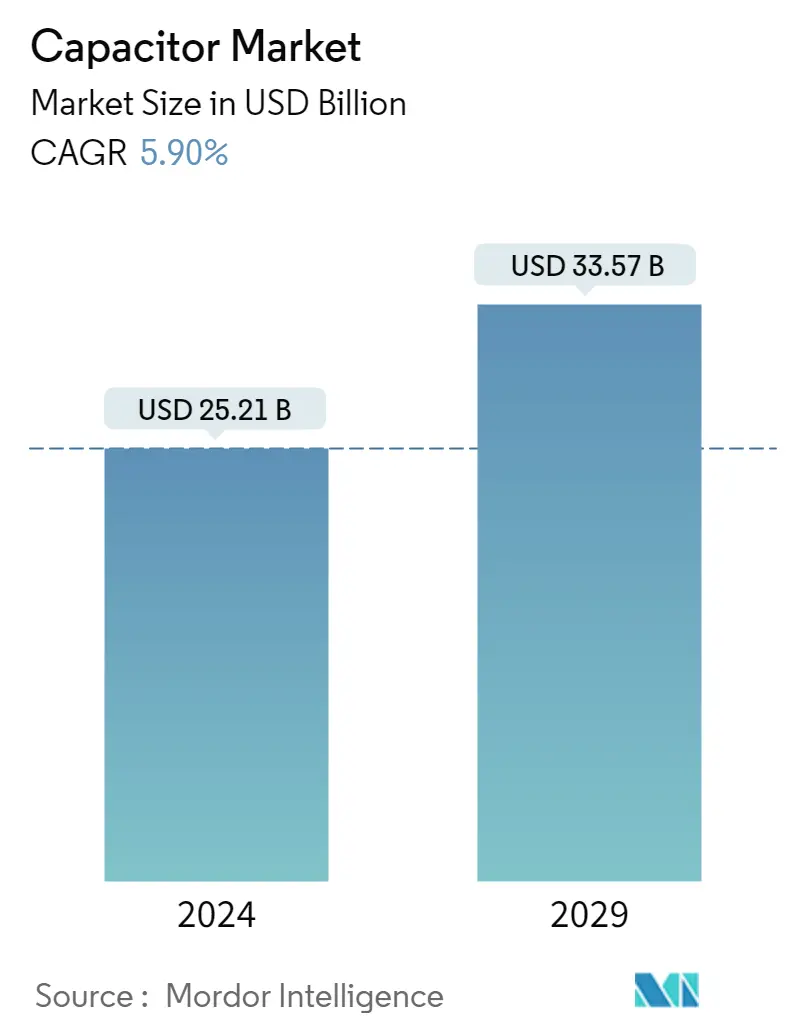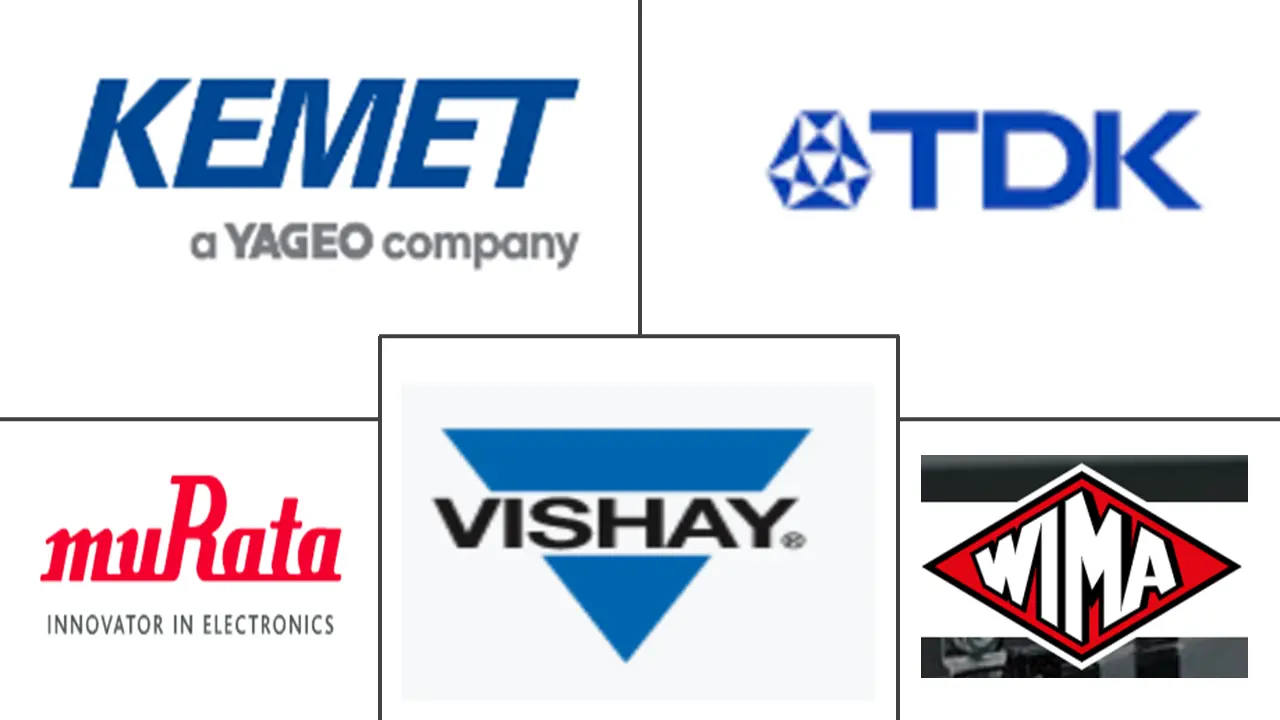Market Size of Capacitor Industry

| Study Period | 2019 - 2029 |
| Base Year For Estimation | 2023 |
| Market Size (2024) | USD 25.21 Billion |
| Market Size (2029) | USD 33.57 Billion |
| CAGR (2024 - 2029) | 5.90 % |
| Market Concentration | Medium |
Major Players
*Disclaimer: Major Players sorted in no particular order |
Capacitor Market Analysis
The Capacitor Market size is estimated at USD 25.21 billion in 2024, and is expected to reach USD 33.57 billion by 2029, growing at a CAGR of 5.90% during the forecast period (2024-2029).
- PCB miniaturization and advancements in semiconductor and circuit architectures paved the way for the rise in demand for capacitors in various applications, including smartphones.
- As communication base stations become increasingly smaller and use higher frequency bands, designing is becoming more difficult owing to the limited number of components mounted on the substrate and restrictions on the size and operating temperature of components. Due to their lower cost and small size, passive components like capacitors are increasingly preferred for these applications.
- The widespread adoption of 5G smartphones and their increasing functionality stoke demand for further miniaturization and higher electronic circuitry density. For instance, several manufacturers, such as Qualcomm and MediaTek, are introducing chipsets that support 5G, which multiple smartphone manufacturers use. Previously, 5G support was confined to only flagship mobiles; now, mid-level smartphones also support 5G to introduce cheaper chipsets in the market. Such initiatives are increasing the need for ceramic capacitors.
- Among the applications, multilayer ceramic capacitors (MLCC) are essential components of many electronic devices and are widely used in wearable devices and smartphones (approximately 900 to 1100 multilayer ceramic capacitors are installed in smartphones). Moreover, new technologies, like IoT, 5G, and EVs, are highly dependent on the availability of MLCCs, as these fulfill higher efficiency needs. This has driven manufacturers to align their product lines and production capacities to meet the requirements of these technologies.
- Renewable applications such as solar energy-dependent watches and display lights, among other small devices, have increased and have created many application areas for EDLC. In addition, electric double-layer capacitors are used as backup sources of memory in computers and are used together with small batteries. Manufacturers provide these capacitors based on carbon nanotubes and graphene due to the high costs and their limited scalability. Due to evolving green energy applications, improving price-performance ratios, and growing new applications across several industries, there are advancements in double-layer capacitors.
- To reduce the size of the capacitors, the manufacturers are adopting and using various combinations, such as voltage range and optimal dielectric spread, to fulfill the surging needs. As the demand for capacitors is fueled by significant product development in the IoT, consumer electronics, and electric vehicles (EV), any new advancements in these industries have become limited by the capacitor's availability during the shortage, with lead times extending from several months to a year in some cases.
Capacitor Industry Segmentation
A capacitor is a passive electronic component or device that is capable of storing energy in the form of an electric charge. It consists of two conductors in close proximity and insulated from each other.
The capacitor market is segmented by type (ceramic capacitors, tantalum capacitors, aluminum electrolytic capacitors, paper and plastic film capacitors, supercapacitors/EDLCs), by end-user industry (automotive, industrial, aerospace & defense, energy, communications/servers/data storage, consumer electronics, medical), and by geography (Americas, Europe, Middle East & Africa, Asia-pacific (excl. Japan and South Korea), Japan and South Korea). The market sizes and forecasts are provided in terms of value (USD) for all the above segments.
| By Type | |
| Ceramic Capacitors | |
| Tantalum Capacitors | |
| Aluminum Electrolytic Capacitors | |
| Paper and Plastic Film Capacitors | |
| Supercapacitors/EDLCs |
| By End-user Industry | |
| Automotive | |
| Industrial | |
| Aerospace and Defense | |
| Energy | |
| Communications/Servers/Data Storage | |
| Consumer Electronics | |
| Medical |
| By Geography | |
| Americas | |
| Europe, Middle East and Africa | |
| Asia Pacific (Excl. Japan and South Korea) | |
| Japan and South Korea |
Capacitor Market Size Summary
The capacitor market is poised for significant growth, driven by advancements in technology and increasing demand across various sectors. The miniaturization of PCBs and advancements in semiconductor and circuit architectures have spurred the demand for capacitors, particularly in applications like smartphones and communication base stations. The shift towards 5G technology and the need for higher electronic circuitry density have further fueled this demand, with manufacturers like Qualcomm and MediaTek introducing chipsets that support 5G across a broader range of devices. Multilayer ceramic capacitors (MLCCs) are particularly crucial, finding extensive use in smartphones and wearable devices, and are essential for emerging technologies such as IoT, 5G, and electric vehicles (EVs). The automotive industry, especially with the rise of self-driving vehicles and advanced driver assistance systems, is also driving the demand for MLCCs, as these components are integral to the functionality and efficiency of modern vehicles.
The Asia-Pacific region, particularly China, is a key market for capacitors, driven by the burgeoning automotive and EV industries. China's government initiatives to promote green transportation solutions have significantly boosted the adoption of electric vehicles, thereby increasing the demand for capacitors. The region is also witnessing substantial investments, with companies like Exxelia acquiring local firms to expand their presence. The capacitor market is semi-consolidated, with major players like Murata Manufacturing, TDK Corporation, and KEMET Corporation leading the charge through strategic collaborations and product innovations. Recent developments include the introduction of silicon capacitors by ROHM and Kyocera Corporation, which offer higher performance in more compact designs, catering to the growing needs of the smartphone and wearable device industries. These advancements, coupled with the increasing demand for capacitors in various applications, underscore the market's robust growth trajectory.
Capacitor Market Size - Table of Contents
-
1. MARKET INSIGHTS
-
1.1 Market Overview
-
1.2 Value Chain Analysis
-
1.3 Industry Attractiveness - Porter's Five Forces Analysis
-
1.3.1 Bargaining Power of Buyers
-
1.3.2 Bargaining Power of Suppliers
-
1.3.3 Threat of New Entrants
-
1.3.4 Threat of Substitute Products
-
1.3.5 Intensity of Competitive Rivalry
-
-
1.4 Macro-Economic Analysis of the Market
-
-
2. MARKET SEGMENTATION
-
2.1 By Type
-
2.1.1 Ceramic Capacitors
-
2.1.2 Tantalum Capacitors
-
2.1.3 Aluminum Electrolytic Capacitors
-
2.1.4 Paper and Plastic Film Capacitors
-
2.1.5 Supercapacitors/EDLCs
-
-
2.2 By End-user Industry
-
2.2.1 Automotive
-
2.2.2 Industrial
-
2.2.3 Aerospace and Defense
-
2.2.4 Energy
-
2.2.5 Communications/Servers/Data Storage
-
2.2.6 Consumer Electronics
-
2.2.7 Medical
-
-
2.3 By Geography
-
2.3.1 Americas
-
2.3.2 Europe, Middle East and Africa
-
2.3.3 Asia Pacific (Excl. Japan and South Korea)
-
2.3.4 Japan and South Korea
-
-
Capacitor Market Size FAQs
How big is the Capacitor Market?
The Capacitor Market size is expected to reach USD 25.21 billion in 2024 and grow at a CAGR of 5.90% to reach USD 33.57 billion by 2029.
What is the current Capacitor Market size?
In 2024, the Capacitor Market size is expected to reach USD 25.21 billion.

